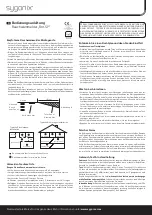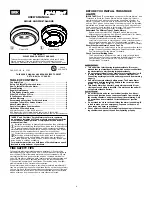
The home technology brand for the entire house. More information at
www.sygonix.com
GB
Operating instructions
Smoke Detector „R01-SY“
Recommended mounting locations for
the smoke detector
• Place the smoke detector in the direct proximity of bedrooms. Keep all bedroom
escape routes free, as usually these rooms are located furthest from exits. If there
is more than one sleeping area, install additional smoke detectors in each sleeping
area.
• Install smoke detectors to secure stairs; stairs can easily serve as chimneys for smo-
ke and
fl
ames and account for further propagation.
• Install at least one smoke detector on each level.
• Install smoke detectors in rooms where smokers sleep or in rooms containing elec-
trical equipment.
• Smoke and other combustion residues rise to the ceiling and spread horizontally.
Place the smoke detector on the ceiling in the middle of the room, as this point is
the closest to all other positions in the room. A ceiling mounting is recommended
in conventional residential buildings. In mobile homes (travel trailers) however, an
installation on inside walls is necessary in order to prevent a thermal barrier that can
form on the ceiling.
• If you should mount the smoke detector on the ceiling, make sure to place it at least
50 cm from the sidewalls and 61 cm from each corner (see
fi
gure A).
The smoke detector must be installed at a strut which is suspended from the ceiling
or at similar locations. Always ensure the minimum distance to corners and walls.
>61 cm
Ceiling
Heat and
smoke
from the fire
At best here
Dead room
Never here
Typical one-level installation
Typical several-level installation
Bedroom
Bath-
room
Living room
Bedroom
Bedroom
Kitchen
Bedroom
Living room
Family room
Entrance hall
Smoke detector for additional protection
Smoke detector for minimal protection
Figure A
Avoid these locations
Do not install the smoke detector in:
• Kitchen – kitchen smoke could start up the alarm unintentionally.
• Garages – combustion residues develop also when you start your car.
• In front or in the proximity of heating installations or air conditioners
• At the highest point of ”A”-shaped roofs
• In rooms where temperatures fall below 5 °C or rise above 38 °C
• Do not
fi
x a smoke detector at the ceiling of a trailer or similar rooms. Sunrays warm-
up the ceiling and the air in the upper part of the room. Hot air at the ceiling can stop
the smoke of a dangerous smoldering
fi
re from reaching the smoke detector.
Create an escape plan and practice for an emergency
Principles of an escape plan
• Create a
fl
oor plan that illustrates all doors and windows and assigns, if possible,
two escape routes out of each room. For windows in the second
fl
oor, a rope ladder
might be necessary.
• Organize a family meeting in order to discuss the escape plan and to instruct each
person what must be done in case of
fi
re/smoke.
• Designate a location outside your home as meeting point.
• Make sure everyone is familiar with the sound of the smoke detector and that they
know how to exit immediately when this sound resounds.
• Identify nurseries with red stickers in the upper left corner of windows. The stickers
are available at local
fi
re departments.
• Practice a
fi
re alarm at least every 6 months. Fire drills help you to test your escape
plan in case of emergency. It could happen that you would not be able to reach your
children to help them. It is important that children know what to do and how to
behave.
What to do when the alarm resounds
• Leave the house immediately according to the escape plan. Each second counts;
therefore do not waste any time to get dressed or to collect valuable objects.
• When leaving the house do not open any door before touching the surface
fi
rst. If
the surface is hot or if smoke pours in from under the door, do not open the door!
Instead of that use the alternative escape route.
If the surface of the door is cool, press your shoulder against it, open the door slight-
ly and be ready to bang it if heat and smoke penetrate from the room located behind
it.
• Get down on the
fl
oor if the air is smoke-
fi
lled. Breath through a moistened cloth, if
possible.
• Once outside, go to your meeting point and make sure that everybody is there.
• Call the
fi
re department from your neighbor’s house, not from your own house!
• Do not return to your house again until the
fi
re department allows you to do so.
False alarm
The installation of a smoke detector should exclude false alarms. Normally, smoke
from cigarettes does not release an alarm, unless it is blown directly onto the smoke
detector. Combustion particles, which can form during cooking can actuate an alarm if
the smoke detector is installed in the proximity of the cooking installation.
Should the smoke detector actuate an alarm, check
fi
rst if seats of
fi
re really exist.
Should a
fi
re be detected, inform your relatives and leave the building together. Call
the
fi
re department. If there is no
fi
re, check if the reasons stated above could have
actuated the alarm.
Usage, testing & maintenance
Usage:
The smoke detector functions as soon as the battery is inserted. If combusti-
on products are detected, then a loud alarm resounds which stops as soon as the air
is smoke free again.
Testing:
Test the smoke detector by actuating the test button for at least 4 seconds
until the alarm (>85 dB(A)) resounds. A self-test program is activated, the alarm re-
sounds if the electronics, the signal transmitter and the battery function.
It is highly recommended to
Test
the device
weekly in order to guarantee proper
functioning.
If no alarm resounds, then the battery could be empty. Replace the bat-
tery and check once more.
Maintenance:
Your smoke detector hardly needs maintenance or care. In rooms with
much dust, you should clean the outside of the smoke detector carefully once or twice
a month with a vacuum cleaner. In other rooms, cleaning it every 5 to 6 months is
enough.
THE SMOKE DETECTOR DOES NOT FUNCTION WITHOUT BATTERY. A NEW BATTE-
RY MUST BE INSERTED IF THE ”WEAK BATTERY” SIGNAL RESOUNDS. CHECK THE
SMOKE DETECTOR WEEKLY AND AFTER EACH BATTERY REPLACEMENT BY PRES-
SING DOWN AND HOLDING THE CONTROL BUTTON FOR AT LEAST FOUR SECONDS.
READ AND OBSERVE ALL INSTRUCTIONS IN ORDER TO GUARANTEE A SAFE FUNC-
TIONING OF THE DEVICE.


























